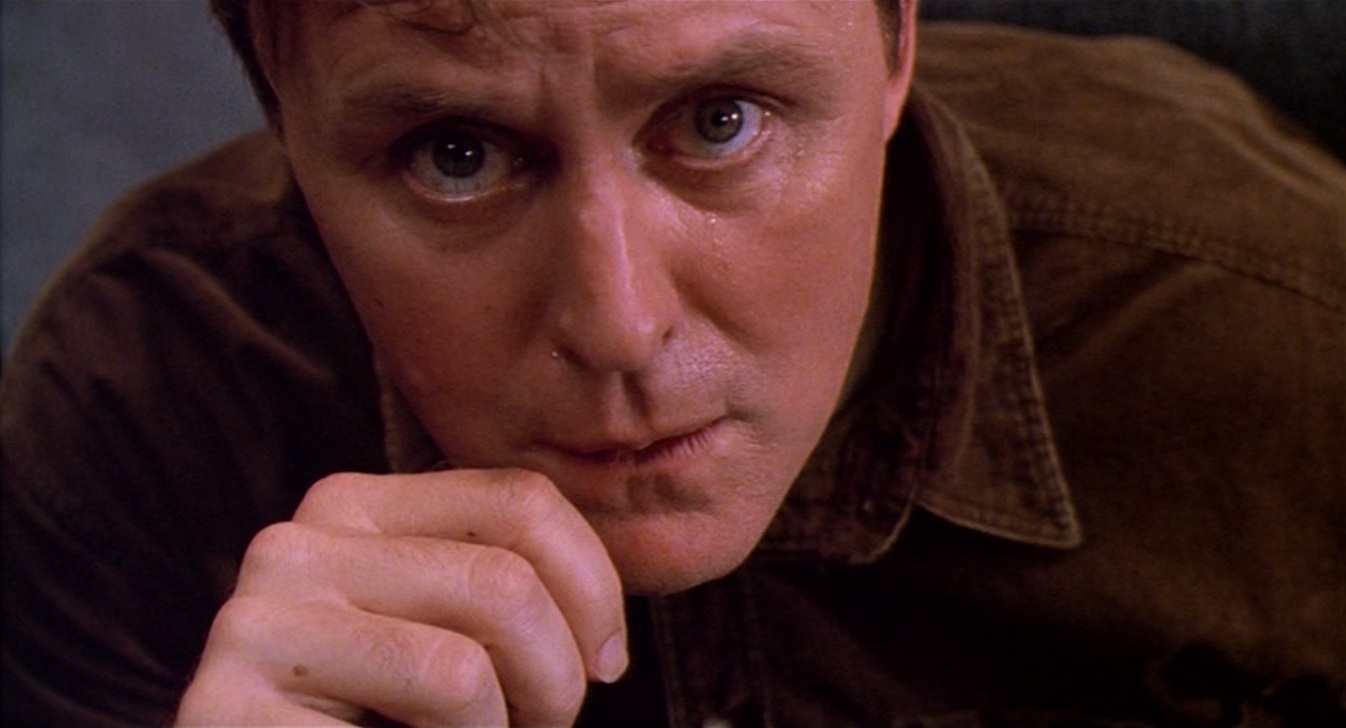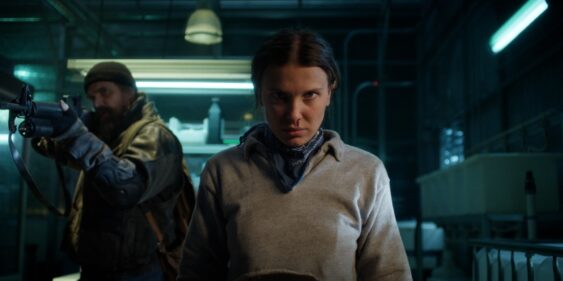In an article I once wrote for this site a couple of years ago, I stated that “if you ever want to instigate a massive argument among cineastes, simply mention the name ‘Brian De Palma’ and watch the sparks fly.” But if you ever want to start a similar argument among fans of De Palma, all you have to do is mention his 1992 film “Raising Cain” to get the ball rolling. Even among fans of the filmmaker’s often-divisive oeuvre, this particular work has been a source of contention ever since it was first released. Some—this writer included—have praised it as De Palma’s brilliantly witty and stylistically audacious deconstruction of the suspense thriller genre that he made his name with, while others have derided it as an unintentionally hilarious mess that saw the filmmaker deploying all sorts of empty visual pyrotechnics in an ultimately unsuccessful attempt to cover up for an incoherent screenplay. Even De Palma himself has seemed a bit at odds with the project at times—in a 2006 interview with CHUD.com, he admitted that he could never quite get the opening scenes to work in the way that he initially conceived them and in fact, he rearranged the structure of the entire film during the post-production process as a result.
Of course, De Palma has made a number of films that were not particularly well-received when they first came out, only to grow in stature with critics and audiences over the years—“Blow Out” (1981) and “Scarface” (1983) being perhaps the best-known examples of such reevaluations. Now, with interest in De Palma’s career as a whole on a rise thanks to the success of the recent career-spanning documentary “De Palma” (itself now available on Blu-ray), it seems the perfect time to revisit “Raising Cain” and finally recognize it as one of the most formally daring and deliriously entertaining works of his entire career. To that end, Shout! Factory has put together a new collector’s edition of the film that not only offers up a beautiful presentation of the original theatrical release but also presents, for the first time, a brand-new Director’s Cut of the film that restores the original structure as De Palma initially conceived it before the post-production rejiggering. This new version of the film adds yet another facet of interest to what I feel is one of the best and most underrated films in the career of one of the best and most underrated American filmmakers of our time.
At the time of the making of the film, De Palma was in the middle of a pronounced and highly public career slump. In the wake of the enormous success of his 1987 hit “The Untouchables,” he used the clout he had earned to make his long-standing passion project—the grim Vietnam drama “Casualties of War” (1989), a film that sharply divided critics and which did not do particularly well at the box office. By the time that film was released, he already had his next job—against all odds, he won the coveted job of bringing the Tom Wolfe best-seller “The Bonfire of the Vanities” to the big screen. Unfortunately, thanks to miscasting and a screenplay that inexplicably softened Wolfe’s razor-sharp social satire into mush, the resulting film, while not quite as bad as its reputation would suggest, would prove to be an enormous flop—one made all the more embarrassing by the fact that De Palma had allowed writer Julie Salamon to observe the entire production in order to write a no-holds-barred book about it, The Devil’s Candy, that would go on to become a bigger success than the film it chronicled. Even though the book showed De Palma to have been at the mercy of meddling producers who were determined to make the film into something that it simply was never going to be, he was the one left holding the bag as the focus of blame when the dust settled. Perhaps looking for something that better fit the kind of filmmaking he was used to after spending the last few years of moving away from that style of storytelling, De Palma, working as his own screenwriter for the first time since “Blow Out,” came up with one doozy of a narrative—one that simultaneously embraced the suspense thriller genre that he knew so well and allowed him enough room to not only play with the form but to wickedly spoof it as well.
The central figure of the film is Carter Nix (John Lithgow) and from all appearances, he seems to be the the perfect man—a respected child psychologist, a loving husband to wife Jenny (Lolita Davidovich) and a devoted father to their young daughter Amy. He is so devoted, in fact, that he has decided to take a year off from his practice to dedicate all of his time to taking care of the kid. It sounds like a dream for Jenny but after a while, Carter’s dedication to the kid begins to slips over into obsession as he also seems to look upon her development as a kind of scientific experiment. Jenny is driven further to distraction after a chance run-in with Jack Dante (Steven Bauer), an old flame whom she met years before when he was the husband of a terminally ill cancer patient that she was treating. Before long, she is sneaking off with him for a couple of mid-afternoon trysts but what she doesn’t realize is that Carter has already seen the two of them together and knows what is going on.
What nobody seems to realize is that beneath Carter’s seemingly placid exterior is a man suffering from a severe multiple personality disorder that was the result of childhood abuse inflicted on him by his own father, renowned Norwegian child psychologist Carter Nix Sr., so that he could use the results for his own studies. As a result, Carter now has at least three other personalities battling for space in his mind—violent killer Cain, ten-year-old Josh and Margo, who appears to be the most fearsome of the bunch. A couple of decades earlier, Carter’s father was arrested for attempting to buy babies in order to continue his experiments and committed suicide after skipping bail. It now appears that Carter, with the help of Cain, has decided to continue those experiments himself and has been killing mothers from the local playground and taking their children. And then …. well, let’s just say that from this point, things get weird.

As originally conceived by De Palma, “Raising Cain” began by focusing on Jenny and her story involving her increasing worries about Carter and her reunion with Jack. This segment would have gone on for about 25 minutes or so until abruptly ending to make way for an extended flashback involving Carter and the murderous activities that he has been undertaking more or less at the same time that the other stuff has been going on. During the editing process, however, De Palma began to worry that by focusing on the softer and more soap opera-like material involving Jenny and Jack, he might run the risk of losing the audience. At the same time, the stuff involving Carter and Cain was so strong and colorful that it seemed almost perverse to keep it from the audience for that long. Because of this—and possibly also because he might have been feeling a little bit gun-shy after the failure of “Bonfire of the Vanities”—De Palma made the last-minute decision to reverse the order of the opening scenes by putting the Carter/Cain stuff up right at the front and holding off on the stuff involving Jenny until later, a move that also gave the film a more strictly chronological order than it previously had.
After watching both cuts of the film, it is easy to understand why De Palma would make the decision to change things around and bring the Cain material to the forefront—it grabs audiences quicker and also introduces them up front to the combination of violence and subversive humor he is playing with this time around. However, the recut proves within a shadow of a doubt that his original instincts were correct. By shifting the focus to Jenny and the reemergence of her relationship with Jack, the film lulls us into the same kind of romantic reverie that her character his experiencing (indeed, much of this sequence is shot in the manner of a soap opera) so that when the film does make its narrative pivot about 25 minutes in, the moment is genuinely startling. The other advantage to putting this material first is that by introducing Jenny and Jack’s relationship earlier, it continues to sit in our mind and accumulate psychic weight during the extended Carter flashback so that it finally winds up earning the importance that the film puts on it, which was one of the biggest problems with the original release version. As for the extended Carter flashback sequence, while the idea of stopping the narrative in its tracks to spend the next 20-odd minutes filling in what was happening in the background of the stuff that we already saw might have given even De Palma pause back in the day, the subsequent success of such films as “Reservoir Dogs,” “Pulp Fiction” and “Memento” would show that audiences could be accepting of such structural gymnastics. De Palma’s only crime in this regard was once again being ahead of the curve in terms of presenting information to viewers.
Regardless of which version of the film one watches, “Raising Cain,” despite appearing on the surface to being a case of a director returning to tried and true material in the wake of a couple of high-profile failures, remains one of the most audacious and ambitious works of De Palma’s entire career. With his sheer technical skills as a filmmaker, De Palma could have easily cranked out a perfectly straightforward thriller of the highest order without breaking a sweat. But it is obvious that doing such a thing no longer held much interest for him. Instead of doing that, he was clearly more interested in offering viewers his own cheerfully acerbic, darkly humored deconstruction of the suspense genre that would tell a compelling story while at the same time commenting on it as well. Utilizing a screenplay that unashamedly wears its influences on its sleeve for all to see—“Psycho,” of course, but also Michael Powell’s infamous psycho-thriller classic “Peeping Tom” and his own filmography for good measure—he gives viewers a story that is constantly messing with audience expectations and forcing them to be on their toes throughout to see where he takes them next. Of course, for those who are just looking for a perfectly straightforward thriller, De Palma’s stylistic and narrative manipulations may prove to be distracting at best and off-putting at worst. Then again, if a straightforward thriller was all they wanted, perhaps a De Palma film was not the way to go in the first place.

One of the biggest bones of contention about the film has always been in regards to the laughter that it does inspire throughout—is it a genuine example of wonderfully absurdist black humor, as its proponents suggest, or is it such a luridly overheated mess that it doesn’t work as anything other than camp? This is a question that has dogged the film since its infamous first press preview in Los Angeles, where the journalists were given press notes that stressed the thriller aspects and offered no suggestion that any of it was supposed to be funny. (De Palma himself would then rewrite the notes in order to bring attention to the comedic aspects, a move that at the time was largely dismissed as an attempt to cover his tracks and reposition a film that allegedly was not working as it was supposed to be.) This debate has always puzzled me because even in the original theatrical version, it is pretty clear that there is a lot of humor in the film and that it is all supposed to be there. Granted, De Palma’s sense of humor may be much darker than that of the average filmmaker but when you get a load of a scene like the one where we flash back to Jenny and the still-married Jack first succumbing to their slowly-gestating passion for each other, only to have their secret discovered under the grisliest of circumstances, it is pretty clear that he is going for laughs.
He also has a lot of fun, not just by the way that he manipulates the goings-on but by the way that he cheekily points out those very manipulations. At one point in the film, there is the scene that every film of this type has to have—the moment where everything stops dead so that someone can come on and basically spout off several pages of raw plot exposition in order to get viewers fully up to speed. This is the kind of scene that can stymie even the greatest of filmmakers—even Hitchcock himself struggled with such a scene, as he showed when he let the otherwise spellbinding “Psycho” bog down by bringing in the psychiatrist to “explain” Norman Bates to us in the final moments. Here, De Palma has a similar scene when he brings in Frances Sternhagen as a former colleague of Carter’s presumed-dead father to inform the police (and the audience) about the true nature of his work and how it relates to Carter. Instead of doing the expected and just filming the scene with a bunch of people sitting around a table talking, De Palma uses the lull in the dramatic proceedings to offer up one of his most ambitious visual spectacles by shooting the discussion in one unbroken shot lasting maybe five minutes or so that finds Sternhagen and the cops wandering up and down several floors and through the hallways of the police station while having their talk. This is clever enough from a technical standpoint. But what makes the scene utterly inspired comedically is that De Palma is not just goofing on that kind of dull-but-necessary information-imparting scene but also on the kind of showy unbroken shots that invariably call attention to themselves that he was, of course, famous for doing—here, he wittily subverts his own showiness by having several moments where Sternhagen almost wanders out for the frame, only to be pulled back in by her co-stars.
There is a lot of other stuff to love in “Raising Cain” as well. Cinematographer Stephen Burum, who had previously worked with De Palma on “Body Double” and “The Untouchables,” does a beautiful job behind the camera, whether finding the dreamy soft-focus romance of the early scenes, uncovering the creepy side of an otherwise innocuous playground or expertly capturing one of De Palma’s complicated flights of visual fancy. Another longtime collaborator of the director, composer Pino Donaggio, turns in a wonderful and surprisingly underrated score that helps drive the film along during its numerous dialogue-free passages. Best of all, there is the knockout performance—maybe “performances” is the right word—by John Lithgow as Carter and the various facets of his tortured psyche. De Palma had worked with the actor in the past in “Obsession” and on his masterpiece “Blow Out” and clearly trusted that he was the man who could bring the complicated role to life and does he ever. Watching him playing against himself—the tortured good guy Carter vs. the cheerfully monstrous Cain—is an absolute blast that only gets better when the other personalities begin cropping up as well. The scene in which Carter is being interviewed by his late father’s colleague and begins switching personalities is a little master class in acting in the way that it makes it work as dark comedy (because of the weirdness of the entire situation), suspense (because we know that something nasty is going to happen at some point) and as poignant drama (because he makes sure to remind us that this character is the way that he is because of a childhood filled with unimaginable abuse at the hands of his own father). A couple of weeks ago, I suggested that “The Adventures of Buckaroo Banzai: Across the Eighth Dimension” contained the actor’s greatest and most deliriously off-the-wall performance. I still stand by that assessment but I promise you that his work here is a close second … a very close second.

As for this new special edition two-disc Blu-ray from Shout! Factory, it should more than satisfy the film’s fan base while still holding interest for newcomers as well. On one disc, there is the original version of the film as well as new interviews with Lithgow, co-stars Steven Bauer, Gregg Henry, Tom Bauer and Mel Harris and editor Paul Hirsch. On the second disc, there is the new Director’s Cut restoring the original concept of the film along with a couple of featurettes explaining the differences between the two versions and how it came to be in the first place. It seems that one of the people who read that 2006 CHUD.com interview where De Palma discussed his original intentions for the film was a freelance director/editor from the Netherlands named Peet Gelderblom. After finding a copy of the original script that included the initial structure online, Gelderblom loaded the film onto his computer, reassembled it along those lines (as he had no access to any previously deleted material, there is no additional footage in this version save for one repeated shot that was needed to help make a smoother transition between scenes at one point) and posted the results online. Now, so-called fan edits are nothing new—remember all the different versions of “Star Wars, Episode I: The Phantom Menace” that have cropped up sans Jar-Jar Binks over the years?—but this one not only attracted the notice of cineastes who were intrigued to see De Palma’s initial concept restored. It attracted the notice of De Palma himself, who not only praised his efforts for helping to bring back his original vision, he deemed it to be the film’s true director’s cut and lobbied to have a cleaned-up version of it appear on the Blu-ray alongside the theatrical version—after all, it does make sense for a film about a split personality to be presented in two different ways, doesn’t it?
Regardless of which version of the film you choose, “Raising Cain” is one for the books—a thrilling, funny, exciting and creepy exercise in suspense and humor from a master filmmaker firing on all cylinders. Rather than the take-cover project that many dismissed it as at the time of its release, it has proven over time to be a formally dazzling work from one of our greatest directors that, more than ever, deserves a place as one of his major works. Whether you are discovering or rediscovering the film for the first time, you will not only be stunned by just how great it is, you will find yourself wondering how people could have overlooked its brilliance when it first came out. Between the current rise in interest in De Palma’s career as a whole in the wake of the success of the “De Palma” documentary and the interest surrounding this new recut of the film, here is hoping that “Raising Cain” finally gets the attention that it has long deserved.
“Raising Cain” [Collector’s Edition] is now available on Blu-ray via Shout! Factory. To purchase your copy, click here.












